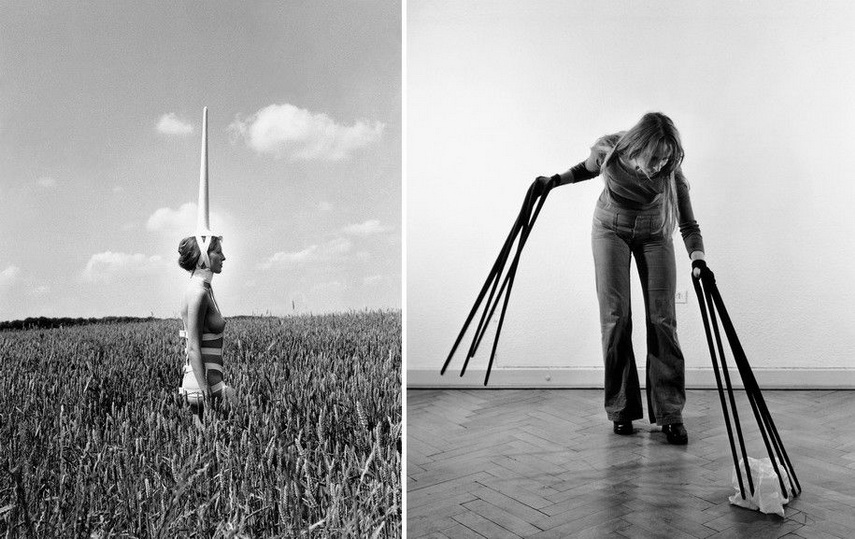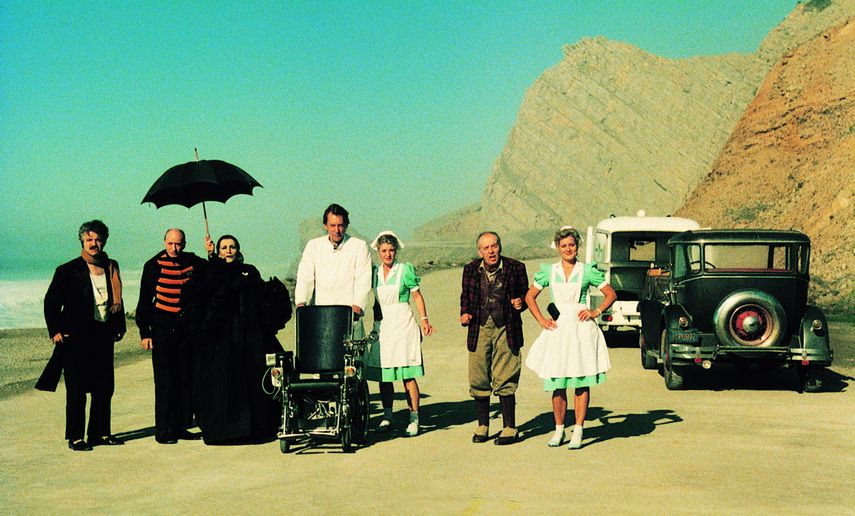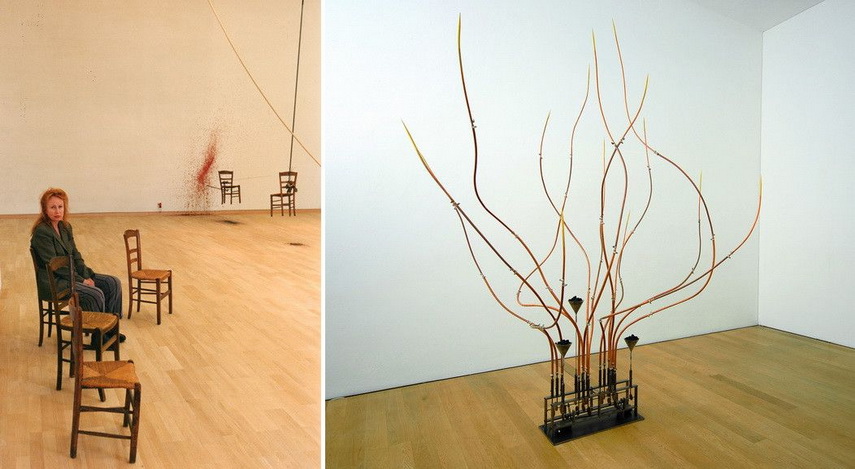Attending Rebecca Horn's Theater of Metamorphoses
The 1960s brought a new generation of artists willing to develop entirely new approaches and break away from the traditional canons of representation. That is how they started embracing new media and producing radical and socially and politically charged works which defied categorization. Not to be mistaken: such an agenda has its continuation and leads us back to the avant-garde experimentation from the interwar period.
Another important aspect of the artistic production of the sixth decade of the 20th century was the increasing presence of women artists, something that was related to the rise of demands for gender equality and emancipation resulting with the Second Wave of feminism in the 1970s. An artist whose practice can be described as a feminist one (although at some points it even transcends specific ideological or political standpoints) is the outstanding Body Art and performance pioneer Rebecca Horn.
By exploring her personal trauma and by focusing on the "man-machine" dichotomy, Horn set off on a peculiar performative based artistic journey saturated with various historical and literary references, humor, and anthropological observations. Throughout five decades of her internationally acclaimed career, she created a compelling body of work consisting of ready-to-wear garments and prosthetic devices, kinetic sculptures, photo performances, and films.
Currently on display at the Centre Pompidou-Metz is a grandiose exhibition titled Theatre of Metamorphoses focused on the omnipresent theme of transformation from various perspectives with a special focus on the role of film in Horn’s practice.

The Oddities of Rebecca Horn
In order to better understand the concept of this particular exhibition, it is useful to mention that Rebecca Horn started using her body as a primer material after she experienced severe intoxication in 1964 while working with glass fiber without using a mask. Ever since, the artist started appropriating an array of associations and drawing inspiration from Surrealism, metaphysics, alchemy, and mythology, leading her to construct an Imaginarium in its core based on hybridity.
This show, curated by Director of the Centre Pompidou-Metz Emma Lavigne, and Alexandra Müller, Head of research and of exhibitions, Centre Pompidou-Metz, is entirely focused on the importance of the body as a vehicle for explorations of possible transformation and (socio-political) transcendence aimed to subvert, seduce, and amuse.
The works of several other artists such as Meret Oppenheim, Constantin Brâncuşi, Man Ray, and Marcel Duchamp to name the few, which were the artist’s spiritual peers throughout her career, will also be on display in order to reveal the referentiality as yet another important aspect of Horn’s work.
The exhibition title indicates that the installment as a whole function as an immersive environment filled with playfulness, humor, and imagination; the interplay of films, sculptures, and mechanized objects tends to show Horn's perception of metamorphosis in broader terms of the human rituals and life cycles.

The Exhibition Segments
The vast installment is based on seven themes which span fourteen rooms. Aside from the introduction, the first segment titled Corps Carcan – Cocon gathers early works made by Horn after the mentioned lung infection and the subsequent recovery; these prosthetic works reflect the artist’s fascination with fetishism, violence, desire, and are contrasted with the works by Alberto Giacometti, with whom Horn shared fascination for the world of robots and for the cinema.
The second segment is titled Wedding parade and dances of death, and it spreads across three rooms. With garments such as masks, fans, clothes feathers, Horn made the body into a hybrid so the frontier between reality and fiction, human and animal, body and machine, desire and violence became blurred. However, as time passed by, she started making kinetic machines deployed of human presence which evoke a certain sensuality and pace of their own. The works present in this segment are accompanied by the ones made by Constantin Brâncuşi.
The Cinema Chamber of Illusions features Horn’s films which reflect anarchic energy where humor and poetry defuse the underlying violence. Initially, the artist used the camera to capture her body performances, while the later works became more elaborate films with complex and often tragicomic narratives inhabited by actors and Horn’s mechanized sculptures. The influence of the underground cinema of Jack Smith, Andy Warhol and Kenneth Anger whose lectures Horn listened the Fine – Arts School of Hamburg) is apparent.
The next part spreads through three rooms and is called Theaters of cruelty. It is based on the work of Antonin Artaud and his "Theatre of Cruelty", proposing the theatre as an arena shared between the actors and the spectators. Horn uses this theatricalization and interprets her performances as ritualistic actions which evoke initiation, a catharsis. The works of Meret Oppenheim will be contrasted with Horn’s.
Finally, Field of Force will explore to the full extent the influence of Dadaism, Surrealism, and alchemy on Horn’s practice, while Music For Anarchy reveals the importance of music e.g. the concepts of synesthesia and dissonance, in her work starting from 1990 installation of a grand piano suspended upside down from the ceiling by heavy wires attached to its legs titled Concert for Anarchy.

Rebecca Horn at the Centre Pompidou-Metz
The current exhibition apparently offers an extensive survey of Rebecca Horn’s work. Interestingly so, the artist herself perceives it as choreography or a musical composition which offers the visitor a particular multimedia experience which transcends all the categories of the history of art (installation, body and video art), and considers is to be a sort of artistic equilibrium.
This showcase coincides with another one called Body Fantasies at the Museum Tinguely in Basel, which puts on display early performative works and later kinetic sculptures in order to underline the transformation processes of body and machine.
Theatre of Metamorphoses will be on display at the Centre Pompidou-Metz until 13 January 2020.
Editors’ Tip: Rebecca Horn. Théâtre des métamorphoses
The exhibition devoted to Rebecca Horn at the Centre Pompidou-Metz will explore the creative process of the artist, exposing the dialogue which was established between her works over five decades, whilst undertaking to put into perspective the sources of influence – surrealist, alchemical, theatrical and cinematographical. By calling upon, in the form of a montage, different systems of images, notably a rich corpus of archival documents, this work opens up new perspectives on the work of Rebecca Horn, looked at again in the light of transversal themes and previously unseen trials, by Philippe-Alain Michaud, curator responsible for the film collection at the Musée national d’Art moderne Centre Pompidou in Paris, as well as the curators Emma Lavigne and Alexandra Müller.
Featured images: Rebecca Horn - Die Kleine Sirene (Little mermaid), 1990. Feathers, motor and metal rod, 172 × 150 × 20 cm. Collection Antoine de Galbert, Paris © Adagp, Paris 2019. Photo: © Celia Pernot; Federfinger, 1973. Rebecca Horn Workshop Adagp, Paris, 2019; Alberto Giacometti - Main prise, 1932. Wood and metal, 20.0 x 59.5 x 27.0 cm. Kunsthaus Zürich, Alberto Giacometti-Stiftung, 1965. Photo credit: Stefan Altenburger © Succession Alberto Giacometti (Fondation Alberto et Annette Giacometti, Paris / Adagp, Paris, 2019); Meret Oppenheim - Das Paar, 1985. Adagp, Paris, 2019. All images courtesy Centre Pompidou-Metz.
Can We Help?
Have a question or a technical issue? Want to learn more about our services to art dealers? Let us know and you'll hear from us within the next 24 hours.

